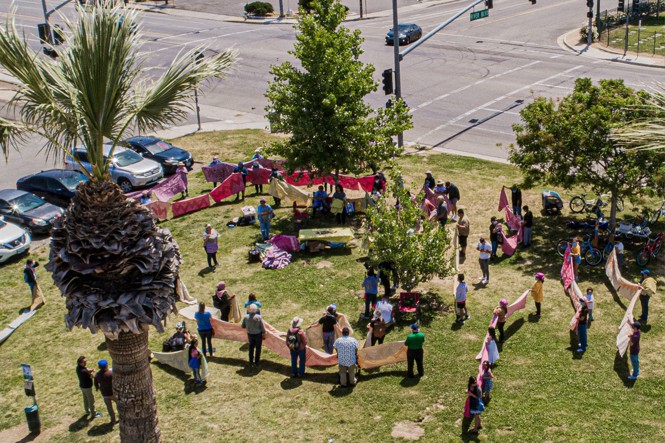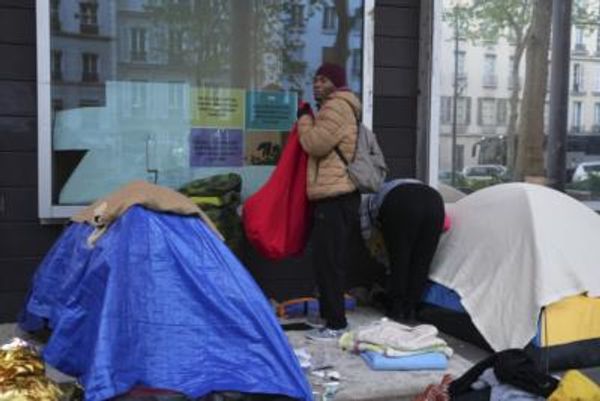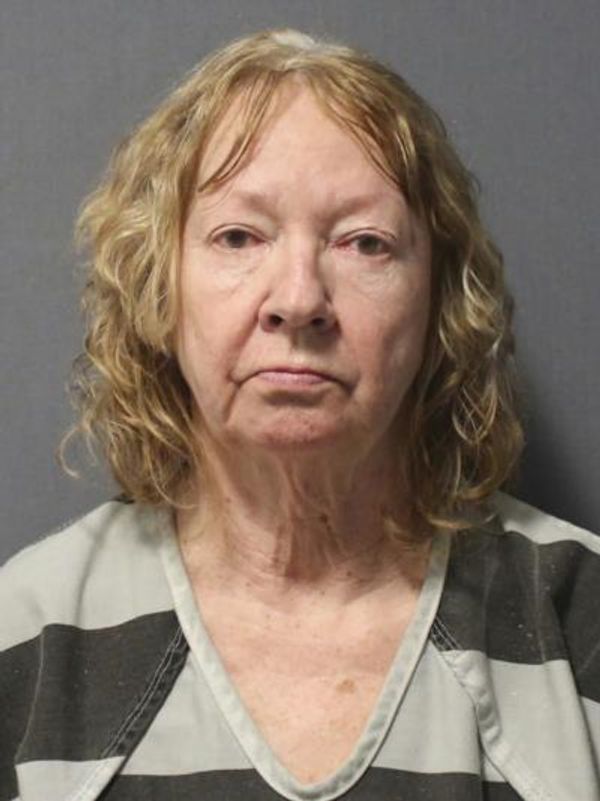
“What is worth more: art or life?” That was the provocative question that the demonstrator Phoebe Plummer asked onlookers at London’s National Gallery last month. Seconds before, Plummer—along with another activist—had splattered tomato soup across Van Gogh’s Sunflowers, superglued one hand to the wall, and kneeled in front of the painting, facing museumgoers in a shirt emblazoned with JUST STOP OIL. In the subsequent weeks, more climate activists defaced other famous works of art at museums across Europe in stunty attempts to draw attention to the climate crisis. “A lot of people, when they saw us, had feelings of shock or horror or outrage,” Plummer told NPR. “Where is that emotional response when it’s our planet and our people that are being destroyed?”
The protesters may have succeeded in grabbing headlines, but their logic was puzzling. As my colleague Robinson Meyer has written, pitting concern for the climate against concern for protecting famous paintings makes little sense. In posing a false choice between art and the environment, the soup protesters backed themselves into a corner, attracting support from neither art lovers nor climate-movement sympathizers.
A better connection between art and climate change exists, and the people who know this best are those who live and work at its intersection: the niche community known as eco-artists.
Capturing the climate crisis in their work requires eco-artists to confront the daily realities of drought, heat, wildfires, and pollution. These conditions converge dramatically in the western states of the U.S., a region that has become synonymous with hazy tangerine skyscapes, charred remnants of forest, and cracked mosaic riverbeds. These images remind us that climate change is about loss—of species, of livable conditions, of beauty. The climate crisis has inspired visual artists to create works that challenge viewers—and themselves—to move beyond shock and outrage, and toward action.
In Colorado, where wildfires are increasing in both intensity and frequency, Anna Kaye has used the changing landscape as reference scenes for her drawings and paintings. After moving to the state in the mid-2000s, she has repeatedly visited the burn zones of the 2002 Hayman Fire—one of the largest in Colorado’s history—to document the wreckage. In Kaye’s watercolor Bluebird and Mountain Dandelion, abstract streaks of brown, black, and green stand in for a tree reshaped by fire, while a detailed mountain bluebird and an orange dandelion perch atop the branches. “It’s incredible to see those slivers of grass that come back out and fight for life, and the roots that resprout and become new plants,” she told me. “There’s power in witnessing that regeneration.”

In contrast with her vibrant, delicate watercolors of the flora and fauna that repopulate burn zones, Kaye has also created large-scale charcoal drawings of fires that she’s witnessed, such as the Indian Gulch Fire, which destroyed 1,700 acres in 2011. “Fire is a challenging [subject] because with it comes trauma,” she said. The resulting drawings inspire optimism less readily; instead, they navigate the friction between the grandeur and terror evoked by large-scale flames.
For Kaye, painting and drawing are the practices that she believes allow her to process living through the climate crisis, but eco-art can also encompass music, poetry, dance, and literature. Perhaps America’s most famous eco-artist is the writer Rachel Carson, whom many consider the mother of the modern environmental movement. In 1962, Carson’s book Silent Spring laid out the harms that human pesticide use was wreaking on the natural world. But as Anelise Chen wrote in The Atlantic, Carson’s body of work was equally focused on inspiring awe at nature’s beauty. People need to feel invested in protecting what they love about the planet, not just sad about its destruction. Silent Spring’s publication may have been a much-needed wake-up call 50 years ago. Today, many people already recognize that climate change is a serious, pressing issue, yet scientists warn that humanity is not moving fast enough to mitigate the worst effects of the crisis. Eco-artists are now faced with a new challenge: How do you move people past their fatigue and grief, and galvanize action?
Kim Abeles has made a career out of trying to answer that question. For 35 years, she has produced art from molecules of Los Angeles smog by layering stencils over glass, wood, or fabric outside on her studio’s rooftop and allowing particulate matter to accumulate. Over time an image emerges, providing a snapshot of the air quality during a particular stretch of days, weeks, or months. Abeles refers to these works as “smog collectors.” One of her motivations, she told me, is to make visible the pollutants that people breathe into their lungs every day. Abeles’s first smog collector, from 1987, traces the silhouette of the San Gabriel Mountains, 50 miles northwest from downtown L.A., which are often obscured by pollution. Over the decades that she’s lived in the L.A. metro area, the mountains have continued to fade in and out of sight, a reminder that Abeles’s work is never truly done.
From the beginning, criticism has been a core objective of Abeles’s smog collectors. Her 2019 addition, World Leaders in Smog, features smog portraits of 10 politicians alongside quotes from their environmental speeches, subverting the notion of “personal responsibility” in combatting climate change. Yes, every person can work to reduce their carbon footprint but, Abeles feels, those measures pale in comparison with the harms that governments and fossil-fuel companies inflict on the Earth. “World leaders, corporate leaders—they’re individuals too,” she said. Former President Donald Trump’s portrait is accompanied by words from his 2017 speech withdrawing from the Paris climate accords: “The United States, under the Trump administration, will continue to be the cleanest and most environmentally friendly country on Earth.”

More than just protest or condemnation, Abeles told me, she wants to use her art to achieve tangible outcomes. Beyond museums, she has displayed her smog collectors in community centers and other public spaces. In the ’90s, the California Bureau of Automotive Repair commissioned her to create and display new smog collectors to encourage drivers to test their emissions and share rides. In another project, making smog collectors with Colorado middle schoolers, Abeles tried to encourage parents to stop idling their cars during afternoon pickup. “Typical data and graphs—how we’re often given material—doesn’t ever hit the emotional part that we really need to tap into,” she said. “I’m not trying to decorate this problem,” Abeles told me.
Indeed, eco-art doesn’t need to be housed in galleries or institutions to reach its intended audiences. For more than a decade, Michelle Glass has held textile workshops with residents of California’s Central Valley, where some of the most polluted cities in the country are located and where poor air quality and water contamination have jeopardized residents’ health. In recent years, the region has had the highest rates of asthma and asthma-related hospitalizations in the state. Like Abeles’s smog collectors, Glass’s works (made of natural dyes and fibers) strive to educate residents about the environmental harms in their backyards and then move them toward change. In her workshops, Glass uses local plants and tap water to dye fabrics—relying on the environment itself as the medium. She told me she finds art to be the most effective way to communicate with the women who attend her workshops—many of whom are older immigrants from Mexico—because it transcends language barriers. “You get the color story of the land. If you’re living in a healthy environment, the colors will be very rich and vibrant,” Glass said. “If you’re not … those colors will be very muted and dull.”

In early 2020, Glass started working on a project titled We Are Here/Estamos Aquí in collaboration with several environmental-justice organizations. Their goal was to make residents conscious of the dangers of living with pollution, and to harness that awareness into individual- and policy-level changes. More than 2 million California residents live within 2,500 feet (nearly half a mile) of an oil or gas well; the Central Valley’s Kern County, where Glass works, produces more than 70 percent of the state’s oil. Living near oil production sites can be hazardous to residents, with drilling exposing them to increased concentrations of air pollutants and wastewater from oil extraction contaminating groundwater sources. When this project started, the organizations had spent nearly 10 years lobbying state legislators to create a buffer zone between oil drills and residential communities without success.
Over the past two years, Glass and the workshop participants created more than 400 fabric panels stretching 2,500 feet: the distance of their proposed setback. They used reds, yellows, and greens—the colors of the air-quality index—and, on Earth Day this year, carried the tapestry in a procession along the Kern River Oil Field. Glass told me that though she believed the demonstration was a culminating moment, the workshops were equally meaningful, as residents learned the truth about their environment, reflected on ways they could reduce their own climate footprints, and contacted their representatives. In September, Governor Gavin Newsom signed into law a bill that will create a buffer zone of 3,200 feet between new oil wells and residents. The California Independent Petroleum Association has already raised $8 million to try to reverse the legislation. “The oil and gas companies and the large businesses are banking on the fact that we’re going to get tired,” Glass said.
But because Glass and other eco-artists believe that the well-being of entire communities and the planet is at stake, they’re committed to pressing ahead. The climate museum protesters don’t seem to be stopping anytime soon, either. Just this past Friday, activists threw flour over a sports car painted by Andy Warhol in Milan. As they become more frequent, the novelty of the museum protests will fade. Creating art, though, can still be a useful tool for the climate movement. “If you just alarm people or critique, we’re only complaining,” Abeles told me. “You have to give people somewhere to go.”







